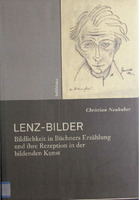Lenz-Bilder
Bildlichkeit in Büchners Erzählung und ihre Rezeption in der bildenden Kunst.
Author(s)
Neuhuber, Christian
Collection
Austrian Science Fund (FWF)Language
GermanAbstract
Since the beginning of reception, Büchner's epoch-making narrative Lenz was praised for its iconic quality, for the suggestive verbal mediacy of visual experience and the evocation of mental pictures. But so far research has paid no attention to the fact that this specific interrelation of language and image also strongly influenced the reception of the narrative in the fine arts. For the first time, this study analyses the complex relations between text and image in Lenz and its reception comprehensively, i.e. in consideration of the trias of literary communication: author, work and (artistic) reader. Firstly it is shown how the text-image-relations form the aesthetic fundament of the narrative as means of composition, but also as thematic, metareflexive element. Subsequently the different forms of imagery are analysed, which are generated in this way. The final part of the study presents illustrations based on Lenz and confronts them with the text. More than 700 pictures from 47 artists could be found, e.g. the expressive self-portraits of Walter Gramatté, Toyen's surrealistic compositions, the 'degenerative' etchings of Susanne Theumer or Thomas Kohl's landscape-representations. Seit Beginn der Rezeption wird Büchners epochale Erzählung Lenz für ihre Bildkraft, für die suggestive sprachliche Vermittlung visueller Erfahrung und Evozierung geistiger Bilder gerühmt. Dass dieses spezifische Naheverhältnis von Sprache und Bild auch die Rezeption in der Bildenden Kunst nachhaltig beeinflusste, wurde jedoch in der Büchner-Forschung bislang so gut wie nicht beachtet. Die vorliegende Studie untersucht die vielschichtigen Beziehungen von Text und Bild im Lenz und in seiner Wirkungsgeschichte erstmals übergreifend, also unter Berücksichtigung der Kommunikationstriade von Werk, Autor und (künstlerisch produktivem) Rezipienten. Dazu wurde der Ansatz der literaturzentrierten Intermedialitätsforschung um den Aspekt einer diachronen Verankerung der intermedialen Kontaktnahme erweitert. Resultat dieser Modifikation in der Theoriebildung war ein dreiteiliges Analyseschema: Zunächst wird gezeigt, wie Text-Bild-Relationen das ästhetische Fundament der Erzählung prägen, indem sie als Gestaltungsmittel, aber auch als thematisches, metareflexives Element Verwendung finden. Daran anschließend werden die verschiedenen Formen von ‚Bildlichkeit' untersucht, die auf diese Weise im Lenz entstehen. Im abschließenden Teil der Arbeit schließlich wird der Text mit seiner produktiven Rezeption in der Bildenden Kunst konfrontiert. Und diese ist, wie sich zeigte, weitaus umfassender als bislang angenommen. Über 700 Arbeiten von vier Dutzend Künstlern aus acht Jahrzehnten konnten eruiert werden, von den expressionistischen Selbstbildnissen Walter Gramattés über die surrealistischen Kompositionen Toyens bis hin zu Susanne Theumers ‚degenerativen' Radierungen oder den Landschaftsrepräsentationen Thomas Kohls. Über den künstlerischen Eigenwert hinaus ermöglichen diese Bilder nicht nur wertvolle Rückschlüsse auf die Rezeptions- und Editionsgeschichte des Lenz. Sie geben auch Aufschluss in kunstgeschichtlichen, buch- und illustrationswissenschaftlichen Fragestellungen und sind nicht zuletzt Anschauungsmaterial, das den rezeptions- und intermedialitätstheoretischen Ansätzen Stringenz und Plastizität zu verleihen imstande ist.
Keywords
Büchner; Lenz; intermediality; imagery in literature; text-image-relations; Lenz-illustrations; Ästhetik; Erzählung; Georg BüchnerDOI
10.26530/oapen_437142OCN
995225852Publisher
BrillPublisher website
https://brill.com/Publication date and place
2009Grantor
Imprint
BöhlauClassification
The Arts


 Download
Download